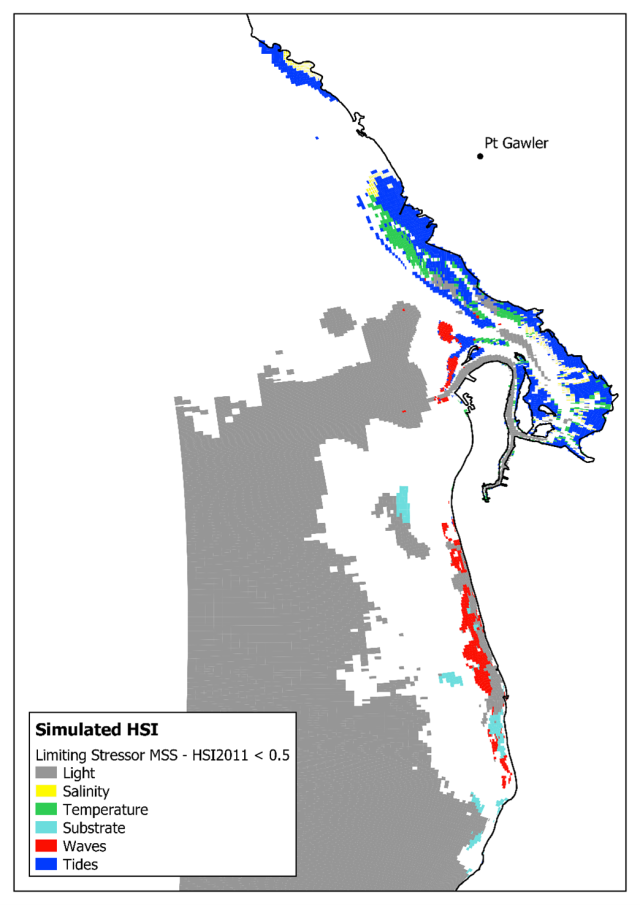The Adelaide Receiving Environment Model (AREM)
To support the optimisation of their operations, South Australia (SA) Water commissioned Deltares to help develop the Adelaide Receiving Environment Model (AREM). The development and application of the AREM model were expected to lead to a better understanding of the present conditions in the Adelaide coastal waters with respect to avoiding further losses of seagrasses and creating conditions for seagrass recolonisation.

Seagrass ecosystems are highly vulnerable to coastal developments. Point in case, the Adelaide coastline in South Australia has lost over 30% of its seagrass cover in the last 70 years. The Adelaide Coastal Waters Study (ACWS, completed in 2007) attributed this deterioration to high nutrient loads that stimulate phytoplankton and epiphyte growth and thus decrease the availability of light for seagrass photosynthesis. High suspended particulate matter (SPM) concentrations (e.g., from rivers) were considered to have a similar effect.
In response, the Adelaide Coastal Water Quality Improvement Program (ACWQIP) stipulated a reduction in nitrogen loads of 75% of 2003 levels (2,400 t) and a reduction in sediment loads of 50% of 2003 levels (8,400 t), as well as an unquantified reduction of coloured dissolved organic matter (CDOM).
SA Water, responsible for discharges from three wastewater treatment plants in the area, concluded in 2012 that understanding of Adelaide coastal waters system functioning was limited. This hindered their capacity to target investment into initiatives for specific areas and periods of the year that would provide clear and measurable environmental outcomes.
To support the optimisation of their operations, SA Water commissioned Deltares to help develop the Adelaide Receiving Environment Model (AREM).
The development of AREM
The AREM contains interconnected models describing the hydrodynamics, waves, fine sediment dynamics and biogeochemistry of the Adelaide Coastal waters, which serve to quantify relevant environmental conditions for seagrass habitat suitability evaluation. These models quantify the effect of local river discharges and discharges of treated wastewater and stormwater on seagrass habitat suitability, considering the morphology, meteorology, and oceanography of the study area.
The first version of AREM was co-created by Deltares, SA Water and DAMCO Consulting, and was completed in 2017. The findings of this work have been recently published in the peer-reviewed journal Marine Pollution Bulletin: Habitat suitability modelling to improve understanding of seagrass loss and recovery and to guide decisions in relation to coastal discharge.
Fitness-for-purpose
In 2017, SA Water successfully carried out a series of scenario simulations to support their Environmental Improvement Program for the years to come. A key finding was that there already had been a significant reduction in wastewater inputs of nitrogen between 2011 and 2015, leading to an increase in the same period of the area simulated as suitable for seagrasses (by 1,436 ha), despite a net increase of particle loads in the same period.
Further investments were expected to have a comparatively smaller effect. Light attenuation in the water column affecting habitat suitability for seagrasses was found to be dominated by other sources (e.g., rivers, natural releases of CDOM) and by wave induced seabed resuspension.
Further developments
Sparked by the findings of the first AREM applications and by extreme weather conditions experienced in SA in 2016, with strong wave action and high particle inputs from rivers, further work was initiated by SA Water. This focused on questions related to the particle dynamics in the area:
- To what extent are the currently resuspended particles anthropogenic or natural?
- What are the time scales associated with anthropogenic particle load changes?
- Is there a lasting impact of weather events like those experienced in 2016?
- Will climate change affect the coastal system assimilation capacity?
SA Water currently addresses such questions by a multiple-lines-of-evidence approach together with local universities and institutes, in which further development of AREM (with Deltares) plays a role, next to field work and earth observation data analyses.

